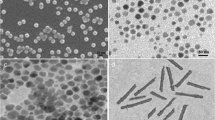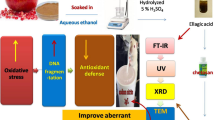Abstract
Objective
The applications of silver nanoparticles in household and biomedical products have become widespread, with scanty information on effects of biogenic nanoparticles on the living system. This work investigated the effects of cocoa pod husk extract-mediated silver nanoparticles (CPHE-AgNPs) on tissues of albino rats.
Methods
Twelve female albino rats were randomly assigned to three groups of four rats each and treated once daily with distilled water, 50 µg/mL, and 100 µg/mL of CPHE-AgNPs intraperitoneally for fourteen days. Activities of selected enzymes were monitored in the serum, liver, kidney and heart. Hepatic and renal function indices, lipid profile, organ-body weight ratios, Hb, PCV and organ histoarchitectural examination were also carried out.
Results
There were significant (p < 0.05) elevations in the heart ALP, liver GGT and AST, serum albumin, creatinine and Na + and K + in response to CPHE-AgNPs treatment. The nanoparticles also caused significant (p < 0.05) reductions in liver ALT and ALP, serum AST, ALP and creatine kinase (CK), liver and heart protein, and serum conjugated bilirubin. However, there were no significant (p > 0.05) changes in serum ALT and GGT, heart aminotransferases and CK, all kidney enzymes, serum total protein, total bilirubin, urea, uric acid, Cl- and lipids. Liver and kidney protein, Hb, PCV, tissue-body weight ratios and histoarchitecture of the organs were also not affected.
Conclusions
This study concludes that CPHE-AgNPs i.p. for fourteen days at 50 and 100 µg/mL exhibited mild hepatic, renal and cardiac cellular toxicities, with functional toxicity of the liver and kidney; an information which may guide safe use of the nanoparticles.






Similar content being viewed by others
References
Oberdörster G, Oberdörster E, Oberdörster J (2005) Nanotoxicology: an emerging discipline evolving from studies of ultrafine particles. Environ Health Perspect 113(7):823–839
Fard JK, Jafari S, Eghbal MA (2015) A review of molecular mechanisms involved in toxicity of nanoparticles. Adv Pharma Bull 5(4):447–454
Li X, Wang L, Fan Y, Feng Q, Cui F (2012) Biocompatibility and toxicity of nanoparticles and nanotubes. J Nanomater. https://doi.org/10.1155/2012/548389
Bahadar H, Maqbool F, Niaz K, Abdollahi M (2016) Toxicity of nanoparticles and an overview of current experimental models. Iran Biomed J 20(1):1–11
Brohi RD, Wang L, Talpur HS, Wu D, Khan FA, Bhattarai D, Rehman Z-U, Farmanullah F, Huo L-J (2017) Toxicity of nanoparticles on the reproductive system in animal models: a review. Front Pharmacol 8:606. https://doi.org/10.3389/fphar.2017.00606
Lateef A, Adelere IA, Gueguim-Kana EB, Asafa TB, Beukes LS (2015) Green synthesis of silver nanoparticles using keratinase obtained from a strain of Bacillus safensis LAU 13. Int Nano Lett 5:29–35
Lateef A, Ojo SA, Akinwale AS, Azeez L, Gueguim-Kana EB, Beukes LS (2015) Biogenic synthesis of silver nanoparticles using cell-free extract of Bacillus safensis LAU 13: antimicrobial, free radical scavenging and larvicidal activities. Biologia 70(10):1295–1306
Lateef A, Ojo SA, Elegbede JA, Azeez MA, Yekeen TA, Akinboro A (2017) Evaluation of some biosynthesized silver nanoparticles for biomedical applications: hydrogen peroxide scavenging, anticoagulant and thrombolytic activities. J Cluster Sci 28:1379–1392
Adelere IA, Lateef A (2016) A novel approach to the green synthesis of metallic nanoparticles: the use of agro-wastes, enzymes, and pigments. Nanotech Rev 5(6):567–587
Lateef A, Azeez MA, Asafa TB, Yekeen TA, Akinboro A, Oladipo IC, Azeez L, Ajibade SE, Ojo SA, Gueguim-Kana EB, Beukes LS (2016) Biogenic synthesis of silver nanoparticles using a pod extract of Cola nitida: antibacterial and antioxidant activities and application as a paint additive. J Taibah Univ Sci 10:551–562
Lateef A, Ojo SA, Oladejo SM (2016) Anti-candida, anti-coagulant and thrombolytic activities of biosynthesized silver nanoparticles using cell-free extract of Bacillus safensis LAU 13. Process Biochem 51:1406–1412
Lateef A, Akande MA, Azeez MA, Ojo SA, Folarin BI, Gueguim-Kana EB, Beukes LS (2016) Phytosynthesis of silver nanoparticles (AgNPs) using miracle fruit plant (Synsepalum dulcificum) for antimicrobial, catalytic, anticoagulant, and thrombolytic applications. Nanotech Rev 5(6):507–520
Lateef A, Ojo SA, Elegbede JA (2016) The emerging roles of arthropods and their metabolites in the green synthesis of metallic nanoparticles. Nanotech Rev 5(6):601–622
Ojo SA, Lateef A, Azeez MA, Oladejo SM, Akinwale AS, Asafa TB, Yekeen TA, Akinboro A, Oladipo IC, Gueguim-Kana EB, Beukes LS (2016) Biomedical and catalytic applications of gold and silver-gold alloy nanoparticles biosynthesized using cell-free extract of Bacillus safensis LAU 13: antifungal, dye degradation, anti-coagulant and thrombolytic activities. IEEE Trans Nanobiosci 15(5):433–442
Azeez L, Lateef A, Adebisi SA (2017) Silver nanoparticles (AgNPs) biosynthesized using pod extract of Cola nitida enhances antioxidant activity and phytochemical composition of Amaranthus caudatus Linn. Appl Nanosci 7:59–66
Azeez L, Lateef A, Wahab AA, Rufai MA, Salau AK, Ebenezer AIO, Ajayi M, Adegbite AM, Adebisi B (2019) Phytomodulatory effects of silver nanoparticles on Corchorus olitorius: its antiphytopathogenic and hepatoprotective potentials. Plant Physiol Biochem 136:109–117
Azeez L, Salau AK, Ogunbode SM (2021) Immobilization efficiency and modulating abilities of silver nanoparticles on biochemical and nutritional parameters in plants: possible mechanisms. In: Abd-Elsalam KA (ed) Nanobiotechnology for plant protection, silver nanomaterials for agri-food applications. Elsevier, India, pp 235–264
Oladipo IC, Lateef A, Elegbede JA, Azeez MA, Asafa TB, Yekeen TA, Akinboro A, Gueguim-Kana EB, Beukes LS, Oluyide TO, Atanda OR (2017) Enterococcus species for the one-pot biofabrication of gold nanoparticles: characterization and nanobiotechnological applications. J Photochem Photobiol B Biol 173:250–257
Olajire AA, Abidemi JJ, Lateef A, Benson NU (2017) Adsorptive desulphurization of model oil by Ag nanoparticles-modified activated carbon prepared from brewer’s spent grains. J Environ Chem Eng 5:147–159
Badmus JA, Oyemomi SA, Adedosu OT, Yekeen TA, Azeez MA, Adebayo EA, Lateef A, Badeggi UM, Botha S, Hussein AA, Marnewick JL (2020) Photo-assisted bio-fabrication of silver nanoparticles using Annona muricata leaf extract: exploring the antioxidant, anti-diabetic, antimicrobial, and cytotoxic activities. Heliyon 6(11):e05413. https://doi.org/10.1016/j.heliyon.2020.e05413
Hussain SM, Hess KL, Gearhart JM, Geiss KT, Schlager JJ (2005) In vitro toxicity of nanoparticles in BRL 3A rat liver cells. Toxicol In Vitro 19:975–983
Oberdörster G (2010) Safety assessment for nanotechnology and nanomedicine: concepts of nanotoxicology (Review). J Internal Med 267:89–105
Krug HF, Wick P (2011) Nanotoxicology: An interdisciplinary challenge. Angew Chem Int Ed 50:1260–1278
Ogunsuyi OI (2019) Cytogenetic and systemic toxicity induced by silver and copper(II)oxide nanoparticles and their mixture in the somatic cells of three eukaryotic organisms. Thesis (PhD). University of Ibadan, Nigeria.
Fadoju OM, Osinowo OA, Ogunsuyi OI, Oyeyemi IT, Alabi OA, Alimba CG, Bakare AA (2020) Interaction of titanium dioxide and zinc oxide nanoparticles induced cytogenotoxicity in Allium cepa. Nucleus 63:159–166
Yekeen TA, Azeez MA, Lateef A, Asafa TB, Oladipo IC, Badmus JA, Adejumo SA, Ajibola AA (2017) Cytogenotoxicity potentials of cocoa pod and bean-mediated green synthesized silver nanoparticles on Allium cepa cells. Caryol Int J Cytol Cytosyst Cytogenet 70(4):366–377
Donaldson K, Stone V, Tran CL, Kreyling W, Borm PJA (2004) Nanotoxicology. Occupat Environ Med 61:727–728
Salau AK, Yakubu MT, Oladiji AT (2018) Effects of Anogeissus leiocarpus root barks on rat liver, kidney and haematological parameters. Toxicol Int 25(2):109–115
Nakkalaa JR, Mataa R, Rajab K, Chandra BK, Sadras SR (2018) Green synthesized silver nanoparticles: catalytic dye degradation, in vitro anticancer activity and in vivo toxicity in rats. Mater Sci Eng C 91:372–381
Ogunbode SM, Salau AK, Azeez L, Osineye SO, Olaogun OO, Adebisi JO, Akinlade HO, Isa FO (2018) Carcass characteristics and selected tissue enzyme activities of birds injected with cocoa pod husk extract-mediated silver nanoparticles (CPHE-AgNPs) at day old. Sci Focus 23(2):81–90
Vignesh V, Anbarasi KF, Karthikeyeni S, Sathiyanarayanan G, Subramanian P, Thirumurugan R (2013) A superficial phyto-assisted synthesis of silver nanoparticles and their assessment on hematological and biochemical parameters in Labeo rohita (Hamilton, 1822). Coll Surf A Physicochem Eng Asp 439:184–192
Adeyemi OS, Adewumi I (2014) Biochemical evaluation of silver nanoparticles in Wistar rats. Int Scholarly Res Notices 2014:196091
Naguib M, Mahmoud UM, Mekkawy IA, Sayed AE-DH (2020) Hepatotoxic effects of silver nanoparticles on Clarias gariepinus; Biochemical, histopathological, and histochemical studies. Toxicol Rep 7:133–141
Pourhamzeh M, Mahmoudian ZG, Saidijam M, Asari MJ, Alizadeh Z (2016) The effect of silver nanoparticles on the biochemical parameters of liver function in serum, and the expression of caspase-3 in the liver tissues of male rats. Avicenna J Med Biochem 4(2):e35557
Salau AK, Yakubu MT, Oladiji AT (2018) Effects of 1:1 mixture of Anogeissus leiocarpus and Terminalia avicennioides root bark extracts on haematological parameters, liver and kidney function indices of male rats. Iran J Toxicol 12(5):41–45
Sulaiman FA, Adeyemi OS, Akanji MA, Oloyede HOB, Sulaiman AA, Olatunde A, Hoseni AA, Olowolafe YV, Nlebedim RN, Muritala H, Nafiu MO, Salawu MO (2015) Biochemical and morphological alterations caused by silver nanoparticles in Wistar rats. J Acute Med 5:96–102
Wall J, Seleci DA, Schworm F, Neuberger R, Link M, Hufnagel M, Schumacher P, Schulz F, Heinrich U, Wohlleben W, Hartwig A (2022) Comparison of metal-based nanoparticles and nanowires: solubility, reactivity, bioavailability and cellular toxicity. Nanomaterials 12:147. https://doi.org/10.3390/nano12010147
Roda E, Bottone MG, Biggiogera M, Milanesi G, Coccini T (2019) Pulmonary and hepatic effects after low dose exposure to nanosilver: early and long-lasting histological and ultrastructural alterations in rat. Toxicol Rep 6:1047–1060
Singh A, Dar MY, Joshi B, Sharma B, Shrivastava S, Shukla S (2018) Phytofabrication of silver nanoparticles: novel drug to overcome hepatocellular ailments. Toxicol Rep 5:333–342
Lateef A, Azeez MA, Asafa TB, Yekeen TA, Akinboro A, Oladipo IC, Azeez L, Ojo SA, Gueguim-Kana EB, Beukes LS (2016) Cocoa pod husk extract mediated biosynthesis of silver nanoparticles: its antimicrobial, antioxidant and larvicidal activities. J Nanostruct Chem 6(2):159–169
Reitman S, Frankel S (1957) A colorimetric method for the determination of glutamic oxaloacetic and glutamic pyruvic transaminases. Am J Clin Pathol 28:56–63
Tietz NW (1994) Textbook of clinical chemistry, 2nd edn. WB Saunders Co., Philadelphia, pp 717–723
Doumas BT, Watson WA, Biggs HG (1971) Albumin standards and measurement of serum album with bromocresol green. Clin Chem Acta 31:87
Evelyn KA, Malloy HT (1938) Micro determination of oxyhaemoblobin, methaemoglobin and sulphaemoglobin in a single sample of blood. J Biol Chem 126:655–661
Wright PJ, Leathwood PD, Plummer DT (1972) Enzymes in rat urine: alkaline phosphatase. Enzymologia 42:317–327
Blass KG, Thierbert RJ, Lam LK (1974) A study of the mechanism of the Jaffe reaction. J Clin Chem Clin Biochem 12:336–343
Veniamin MP, Vakirtzi C (1970) Chemical basis of the carbamido diacetyl micromethod for estimation of urea, citrulline and carbamyl derivatives. Clin Chem 16:3–6
Henry RJ, Cannon DC, Winkleman JW (1974) Clinical chemistry, principles and techniques. Harper and Row 2nd edn.
Folch J, Lees M, Sloane SGH (1957) A simple method for the isolation and purification of total lipids from animal tissues. J Biol Chem 226(1):497–509
Ibrahim ATA (2020) Toxicological impact of green synthesized silver nanoparticles and protective role of different selenium type on Oreochromis niloticus: hematological and biochemical response. J Trace Elements Med Biol 61:126507
Acknowledgements
This project did not receive any specific grant from funding agencies. The authors wish the appreciate the Nanotechnology Research Group (NANO +), Ladoke Akintola University of Technology, Ogbomoso, Oyo State, Nigeria for donating the CPHE-AgNPs used in this study. The authors also wish to appreciate all Laboratory Staff of Fountain University, Osogbo, Osun State, Nigeria for their assistance. Muneerah Muhammad, Fasilat Salako and Aishah Adisa are also appreciated for their contributions to the experimental procedure during their industrial training in the Laboratory Unit of Fountain University, Osogbo.
Author information
Authors and Affiliations
Corresponding author
Ethics declarations
Conflict of interest
A. K. Salau, S. O. Osineye and A. Lateef declare that they have no conflicts of interest.
Ethical statement
This article does not contain any studies with human participants. Statements on ethical approval for animal studies are in the materials and methods section.
Rights and permissions
About this article
Cite this article
Salau, A.K., Osineye, S.O. & Lateef, A. Nanotoxicological investigations of cocoa pod husk extract-mediated silver nanoparticles in selected tissues of albino rats. Toxicol. Environ. Health Sci. 14, 193–202 (2022). https://doi.org/10.1007/s13530-022-00129-6
Accepted:
Published:
Issue Date:
DOI: https://doi.org/10.1007/s13530-022-00129-6




